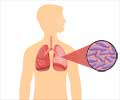Anti folate compounds which can pass the mycobacterium tuberculosis cell passively could be a new treatment option for drug-resistant TB.

‘New drugs causing disruption of the pathway of folic acid, an essential compound for producing DNA and RNA, could be a promising new treatment option for drug-resistant Tuberculosis.’
Read More..




Current treatment protocols require the use of multiple drugs, due to the bacteria's uncanny ability to develop resistance to individual drugs. Drug-resistant strains may be on the rise, due to poor adherence to treatment protocols, says Wright.Read More..
"First-line therapy for drug-susceptible TB is by using three to four drugs in combination," he says. "The mixture is necessary because the pathogen is a master at developing drug resistance."
The treatment time is also at least six months for drug-susceptible strains; but for drug-resistant tuberculosis, it can be 18 months and often longer. Unfortunately, that means adherence to the full treatment, especially in less industrialized areas, is unlikely or impossible for many, Wright says.
A Different Way to Target the Bacteria
At UConn, Wright is taking a new approach, developing drugs that target the bacteria in different ways from previous classes of drugs. He says this approach is intended to help circumvent the pathogen's resistance to existing drugs.
Advertisement
Since it is so important for survival, the folate pathway is also highly conserved - meaning that antifolate drugs could target bacteria, fungi, parasites, but also humans. Therefore just the right compound is needed to ensure that the pathogen, and not the host, is impacted.
Advertisement
The promise for antifolate medications as a new class of drugs for the treatment of TB and many other diseases is great. However, there is currently only one antifolate used to treat TB, called para-aminosalicylic acid (PAS).
Wright and his team compared PAS with 60 antifolates they designed to target a very specific component of the folate pathway called dihydrofolate reductase (DHFR). A collaborator screened the compounds in cultures of Mtb, including drug-resistant strains.
"The Mtb and human DHFR enzymes differ very slightly, but in fact, that single amino acid change in the drug binding site is enough to give us selectivity," says Wright. Not only did the compounds have selectivity in inhibiting the pathogenic DHFR, but they also impacted the ease with which the drug enters the bacterium.
Wright says getting the drugs in is challenging, because TB is one of the hardest microorganisms to penetrate. "It is so drug-resistant due to the waxy outer coating, and because it can hide from the immune system."
Classical antifolates, like methotrexate, require active transport into cells; however, the compounds developed by Wright and his team enter the cell passively. Wright says the folate cycle may also play a role in the bacterium's ability to produce its protective waxy coat, meaning that it could make it easier for other drugs to get in and help clear a TB infection.
Wright says that these two findings were validation that the compounds were targeting what they had hoped to target; and overall, the researchers found their compounds to be more effective than PAS.
He is hopeful that funding agencies will be interested in this promising class of drugs. More work is needed to bring them to the market for the treatment of TB.
"As people are traveling more," he says, "I'm not sure how long TB will stay isolated."
Source-Eurekalert












